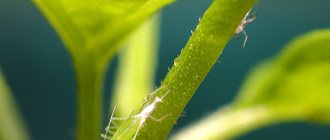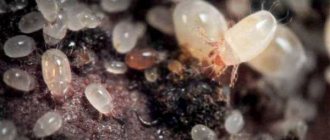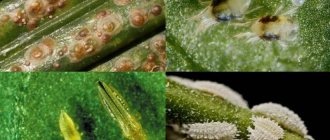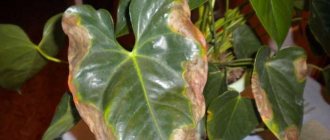- August 22, 2018
- Diseases and pests
- Legina Marina
If a sticky coating appears on your plants, then you need to immediately inspect the bottom of each leaf. The fact is that such symptoms very often indicate the presence of scale insects. Unlike most small pests, it is clearly visible on the surface of the leaf blade. It is the scale insect that is different in that it secretes a sticky liquid that seals the stomata and prevents the plant from breathing. At the same time, this film is an excellent breeding ground for fungi and bacteria. Today we’ll talk about what to do with scale insects on indoor plants and how to fight them. The photo will help you quickly identify this pest and select adequate control methods.
general description
What does this insect look like? This is a tiny creature that can destroy even a large tree. Its body is covered with a dense protective shell, so the scale insects can be mistaken for hard growths on the plant. It’s not for nothing that scale insects have a second name – garden turtle. But they are not at all as harmless as they might seem at first glance. In a couple of weeks, the voracious creatures will destroy any plant.
Every gardener should know well what scale insects look like on indoor plants and how to fight them. The photo shows us females up to 5 mm in length. They are the ones that are found motionless on plants and look like droplets of frozen resin. Males do not grow more than 3 mm and move freely around plants using legs or wings.
Reproduction and life activity
Scale insects live in colonies, which is why they can cause significant damage to the plant. They “suck out” all the useful substances necessary for growth, development and photosynthesis. Scale insects reproduce by laying eggs, from which larvae subsequently emerge . They spread throughout the plant and are localized in small groups. This can be noticed by the appearance of unusual growths and curvatures on the trunk.
Significant damage is:
- drying of shoots;
- yellowing and falling of leaves.
Usually there are one or two generations (offspring) per year. But at one time the female lays about 3000 eggs. As for life expectancy, for males it is only from 1 to 3 days, and for females it is months. But the males have wings, they can fly to different parts of the plant, and even move independently over long distances.
The full development cycle of an insect is 45-65 days. Having destroyed 1 generation, you no longer have to worry about this pest.
Reason for appearance
In the garden everything is clear: young females and males fly freely and cover considerable distances. How does scale insect appear on indoor plants? How to fight? We will look at photos of effective drugs below, but for now we will look at ways of penetration into your home. This is usually soil, plant debris and water. And most often, parasites come to your house with new plants.
They usually begin to fight them when they appear en masse, without previously noticing them. Therefore, a new generation of scale insects spreads into neighboring pots. And only sudden, massive shedding of leaves, inhibition of growth or death of plants can become a signal for the owner that it is time to show maximum care.
Causes of infection and prevention
Most often, scale insects enter the garden with infected planting or grafting material. The larvae can be carried by birds, and the mulberry scale can even be carried by the wind.
Therefore, when buying young seedlings or cuttings for grafting, carefully examine them. And in the future, carry out a systematic inspection of the garden, pay attention to changes in the appearance of plants. For example, if there are red dots on the fruit, then it needs to be examined urgently; Californian scale insects may be detected.
The main preventive measures are:
- crown thinning:
- timely removal of dried and damaged branches, dead trees, and root shoots;
- cleaning of damaged and lagging bark on trunks and skeletal branches;
- proper watering and application of the necessary fertilizers, since a strong plant is more resistant to attack by pests.
Threatened
Scale insects can appear on indoor plants no matter how well you care for them. Moreover, it affects any plant, including succulents. But this pest also has its favorites, which are attacked first. We are talking about orchids and laurels. Palm trees and ivy do not avoid scale insects. With great pleasure, the scale insect feasts on Cyperus, Aucuba and other exotics. The usual household inhabitants are also under attack: chlorophytums, geraniums and hippeastrums.
What is noteworthy is that the pest most often appears in winter and early spring. This is evidenced by numerous amateur photos. How to deal with scale insects on indoor plants? It is necessary to improve the immunity of the plantings. After all, at this time the plants are most weakened, which becomes a decisive factor for the pest. It is much easier for them to harm flowers that are not able to resist. Therefore, follow the recommended conditions, and closer to spring add special immunostimulants to the soil. This could be inexpensive succinic acid.
What trees and shrubs are affected by the pest?
There are practically no restrictions for this parasite among trees and bushes. The soil, garden, winter greenhouse and indoor flowers may also be attacked.
Most often, the comma-shaped insect affects:
- apricot;
- quince;
- thorn;
- linden;
- plum;
- roses;
- honeysuckle;
- peach;
- hawthorn;
- mulberries;
- rowan;
- cotoneaster;
- lilac.
The scale insect is also found on pear, cherry and sweet cherries. Currants, raspberries, cherry plums and apple trees are not all that the insect loves. There are more than a hundred names of flora that scale insects can feed on. Some varieties are capable of attacking even plants that secrete poison for protection.
Damage caused
The larvae wait in the wings, feeding on cell sap. With severe damage, plants become covered with a coating of pest bodies, and it is almost impossible not to notice this. Autumn is coming in your home garden, the leaves are flying away.
The scale insect and its larvae can live and feed on indoor plants all year round, and the insects reproduce very quickly. They reproduce by laying eggs, which contributes to rapid population growth. At the initial stage, the larvae are very mobile, especially the males. But they live only a few days, and the female will feed and breed for several months.
Where does the pest come from on house flowers?
They can be very different. The plant may have already been sold as infected. Then the methods of control depend only on how highly developed the pest is and how much damage it has already caused.
- Scale insect larvae can be carried by the wind, fly onto a balcony or through an open window. Or the infection could have occurred in a summer cottage.
- If a plant is grown in unsuitable conditions for it (too hot, humid, cold, insufficient nutrition, etc.), it also contributes to the appearance of parasites and diseases.
- If a flower is “overfed,” especially with nitrogen, this significantly weakens its immunity.
Do not confuse with false scale insects
This is another pest that appears very similar in appearance. These insects belong to the same order, but they are separated into a separate family. They differ from scale insects in that the latter do not have a waxy shell. Their eggs and larvae are protected by the dry skin of the dying female after laying. In the first stages, small insects move quickly, and this applies to both true and false scale insects. But if you see that a sticky patch begins to form on the leaves, there is no longer any doubt: this is what you are looking at.
Biological portrait of scale insects
Entomologists know about 2,400 species of scale insects. False scale insects are also found in nature. In the latter, the shield is part of the body and is not separated from it. If you try to pick up the scale insect in your hands, the waxy shell will easily detach from the insect. Another sure way to eliminate all doubts about whether it is a scale insect or a false scale insect is to examine the individual under a microscope. The presence of eyes on the shield is a sure sign that this is a representative of false scale insects.
Appearance
Pests can be recognized, even despite the abundance of species, by specific characteristics inherent only to these insects.
- the length of the female body does not exceed 1.5 mm;
- its shape can be either oval or round;
- the female individual lacks wings and legs;
- there is no clear division into the head and abdomen, it looks like a monolithic plaque, in some species the eyes are reduced;
- color from light white flowers to brown, rich dark purple;
- the shield consists of two larval skins and is easily separated from the body;
- The sucking mouthparts are represented by a single or three-segmented lip, proboscis and setae.
The male is smaller than the female. But it has a pair of wings, antennae and legs. In most species, males lack oral apparatus. And there are also varieties in which there are simply no males and females reproduce parogenetically.
Brown scale insects are one of the most common species
The eggs are tiny. The shape and color are determined by the species.
Interesting! The first instar larvae are originally called strays. They have 6 legs, tail setae, developed antennae, eyes and a proboscis folded into a pocket. The size of juveniles is 0.4-0.5 mm. As they grow older, they lose some organs and mobility.
Preventive actions
Below we will talk about how to deal with scale insects on indoor plants, but for now let’s look at what can be done to prevent damage. The following measures will help protect your flowers:
- Constant control of the soil in plant pots. It must be of high quality and clean.
- Dead and weak shoots must be cut off in a timely manner. This will preserve the strength of the plant and prevent rotting. Be sure to disinfect the sections.
- Ventilate the room frequently and maintain the required air humidity.
- Quarantine all new plants for a month. A similar technique should be used when returning your plants from their summer residence in the garden, in the fresh air. There are quite a lot of chances to become infected with scale insects in the garden.
Impact on garden and vegetable plants
Scale insects in the garden cause a lot of trouble for the summer resident. Initially, single tiny oval-shaped scales can be seen on the leaves or branches of plants. These are young female scale insects. The maximum size of an adult female can reach no more than five millimeters.
During the life of the females, sticky spots soon appear on the leaves.
At the same time, you can see through holes in the leaves. The damage was done by females or larvae. Soon the leaf around the hole begins to turn yellow. Then yellowness covers the entire surface of the leaf, and it falls off. The same thing happens with pine needles.
If scale insects have chosen the branches or trunks of fruit trees, then shallow cracks in the bark soon appear there.
On such branches, flowers and ovaries fall off, and they themselves later lose leaves. With an earlier attack, flowering will not occur.
If scale insects infect a plant or tree while the fruit is ripening, the fruit or vegetables become stained and die.
Along with all these troubles, pockets of sooty fungus appear on plants. The disease progresses rapidly, the plants stop growing and may die. The treatment is complex.
As for fruit trees and berry bushes, scale insects prefer to destroy seedlings or young bushes and trees. They quickly destroy a young vineyard, destroy cherry and apple trees in the gardens, feast on gooseberries in the garden, and do not allow the planting of conifers.
Fighting methods
The more pests manage to multiply, the more difficult it will be to get rid of them, and the more severe the damage caused. And the first remedy for scale insects on indoor plants is to pick them from the leaves by hand. It should be noted that the fight against these creatures is long and very difficult. A durable shell reliably protects pests from any damage. Therefore, first of all, we examine the axils and leaves on both sides. A small flat growth is a pest. It must be carefully torn from the plant and destroyed. To make this task easier, you can use a toothbrush. This is only the first, but a very important step. Because by leaving pests on the stems, you give them a chance to reproduce.
Hygiene measures
The fight against scale insects on indoor plants begins with treatment with a soap solution. Most pests cannot tolerate this. Moreover, both the placement of the pots and the vessels themselves will need to be treated. It is best to replace the soil by first calcining the fresh soil mixture.
To prepare a concentrated soap solution you will need 100 g of grated laundry soap and a liter of water. After complete dissolution, add 200 ml of kerosene. All this must be thoroughly mixed until a white foam forms. Before use, the mixture must be diluted in 10 liters of water. After wiping with this solution, the plant is given a warm shower a few hours later, after which it is placed in a warm place to dry. This is one of the gentlest remedies, but it can be quite effective. True, there is a chance that the larvae will survive and give birth again. For complete victory, 2 to 3 treatments may be required at intervals of 7 days. The fight against scale insects on indoor plants can be long and difficult, so let's look at more reliable means.
Signs of scale insects appearing on trees
Severe scale infestation can lead to the death of an entire tree, so it is very important to detect the problem in a timely manner and begin to solve it. The main signs of the presence of scale insects are:
- peeling and cracking of the bark;
California scale insect.
- falling leaves;
- death of main branches and young thin branches;
- decreased quality and premature fruit drop;
- complete death of the tree several years after infection.
Traditional methods
So, we cleaned the plant from pests with a toothbrush, washed it with soapy water and dried it well. Now we consider further how to deal with scale insects on indoor plants using available means:
- Garlic solution gives good results. To do this, add 5 crushed cloves to a glass of water and leave in a dark place. After this, strain through cheesecloth and spray the plant with the solution. You need to carry out a number of treatments to get a good result.
- Pepper infusion. Another advantage is that the solution can be prepared for future use. To do this, boil 50 g of pepper for 5 minutes in 500 g of water. Let it sit for 24 hours and the infusion is ready.
- Celandine. Almost all pests cannot tolerate it. You will need to pour 300 g of dry celandine herb with a liter of boiling water. Leave for 24 hours, then spray the diseased plant.
- Oil film. Insects are living creatures that require air. To block its access, you can lubricate the affected areas with sunflower oil using a brush. The procedure is repeated every day until the insects completely disappear.
The effectiveness of folk remedies is quite difficult to assess. They are safe for humans, which is a big plus. But often gardeners are faced with the fact that the result is temporary and comparable to manual collection of pests. Within a few days, the larva hatches, and the surviving individuals lay new eggs. And now a new generation of pests is destroying your flowers. Of course, on a garden scale it is more difficult to deal with them. But if you have 3 - 5 pots at home, then you can check every leaf every day and not give the pest a single chance.
Symptoms of the lesion
If the larvae can only be seen under a magnifying glass, then the consequences of their “feeding” and development are easy to detect.
The foliage on the plants becomes sticky and shiny, as if they had been smeared with honey. Already at this stage it is too late to start fighting; usually the scale insects are covered with protection. The coating tastes sweet, this is due to the release of sweet and sticky waste by the feeding “vagrants”. Then the shoots and trunks become covered with a grayish coating; due to a lack of nutritious sap, the plant begins to lag behind in development, the foliage becomes small and gradually dries out. The plant’s nutrition from photosynthesis processes is disrupted and, in fact, the plant stops “breathing” through the foliage. Early leaf fall begins, the bark on the trunks and shoots cracks and bends. Find out how to spray currants in the spring against pests and diseases in this material.
Consequences
A gardener who does not carry out preventive treatments against scale insects on currants and other garden plants risks being left without a harvest and will lose seedlings altogether. If at the beginning, due to insufficient nutrition, parts of the bush are depressed, then later the lack of nutrition causes the shoots and trunks of the bush to dry out. This article will tell you about ammonia for aphids on currants.
It is not always possible to reliably protect the garden, even if all preventive treatments are carried out, if the neighboring area is abandoned or not treated for pests. In this case, active males and “vagrants” will quickly fill the neighboring garden and young females will hatch in August.
We use insecticides
A photo of a scale insect on indoor plants makes it clear that it can cause serious damage to any flower, even to the point of its complete death. Therefore, at the first sign of defeat, you need to get down to business. And the most effective way of control is the use of insecticides, that is, treatment with chemicals. But here, too, there is no guarantee that you will get by with just one treatment, because combating this pest requires a systematic approach. The choice of drugs today is quite large. But the most effective can be considered those that are designed to combat dipterous insects, including the Colorado potato beetle.
Some types of scale insects living in our area
The following types of pests most often appear on Russian territory:
- California scale insect;
- mulberry pseudaulacaspis pentagona;
- plum;
- apple comma (in Latin lepidosaphes ulmi);
- beet;
- acacia;
- hazel;
- purple;
- brown;
- willow;
- Rosenaya
This does not mean that there are no other species of this insect in our area. We also have other species, but they are not as widespread as the ones listed above. It's not easy to get rid of them all. There are also false scale insects, which also only cause harm and prevent plants from developing.
"Aktara"
If you have tried traditional methods and are still looking for options on how to get rid of scale insects on indoor plants, then it’s time to move on to more radical measures. This drug affects the nervous system of insect pests, causing paralysis of the respiratory and nervous systems. The product is available in ampoules, which is very convenient.
This product destroys plant-feeding insects at all stages. The drug works equally well when applied to the leaves and watered at the root. That is, it accumulates in the vegetative parts of the plant, which makes it resistant to precipitation.
How to detect scale insects
Not many gardeners, especially beginners, manage to immediately detect the pest, and this is precisely the main reason for its spread. Usually people panic only when they begin to observe massive falling of leaves and wilting of plants.
However, there are several ways in which you can identify a pest and below you can familiarize yourself with them:
- Pay attention to the veins along the leaves. If you find strange convex round bumps or plaques on them, then know that this is a scale insect that needs to be dealt with urgently. Do not pay attention to the color of such tubercles, because in scale insects their shells can take on different shades.
- In the initial stages of appearance, the scale insect is almost impossible to identify due to its small size and camouflage methods. But due to their vital activity, they secrete sticky mucus that covers the leaves. Please note that if the leaves of your plant are sticky, then it is likely that you need to sound the alarm.
- Over time, red spots may appear on the leaves and stems and increase in size. If you also notice tubercles, then most likely your plant has been attacked by a scale insect.
- In later stages, pay attention to the early wilting of the leaves, deformation of the stem and their gradual drying. Inspect the plant, and if you find other signs of a pest attack, you will need to take immediate action.
- Falling of flowers and fruits and growth cessation is the extreme degree of pest damage to a plant. If you observe something like this, then know that by this moment the chance of saving the plant will be 50/50, but it’s worth a try in any case.
It is noteworthy that the scale insect can return to the plant it loves, so treatment must be carried out over a long period of time, preventative work must be constantly carried out, and the plant must also be constantly inspected. Because the reappearance of scale insects will also threaten you with sooty fungus, which will have to be treated separately.
"Aktellik"
And we continue to talk about how to fight scale insects on plants. "Actellik" is a popular insecticide that allows you to quickly deal with garden parasites. The drug "Actellik" CE, that is, a concentrated emulsion packaged in ampoules of 2 ml, contains the active ingredient pirimiphos-methyl. It can affect the pest in the following ways:
- Through outer shells.
- Through the digestive organs.
- through the respiratory tract.
The emulsion is widely used for indoor plants. It is non-toxic to people and pets when used correctly. Today this is one of the best means to combat scale insects.
How to prevent the appearance of uninvited garden guests?
Preventive measures are the most effective protection of plants and trees from scale insects. In order not to miss the appearance of these pests, you need to inspect your plantings daily. Particular attention should be paid to the underside of the leaves. It is there that scale insects prefer to lay eggs and where the first colonies of larvae appear.
A good preventive measure is treating plants and trees with an aqueous solution of Fitosporin-M. Spraying is done in early spring, and watering the soil in late autumn. This biologically active drug has a systemic effect on insects.
The aqueous solution of the product is absorbed into the plants. The active substance enters the insect body along with the juice. It does not have a negative effect on plants. The effect of the drug on insects lasts 20 days.
"Fitoverm"
Experienced gardeners are well acquainted with this drug. It perfectly helps to cope with a wide variety of pests of both garden and potted plants. The drug must be diluted in a proportion of 1 ml per 200 ml of water. Fitoverm is not a highly toxic drug for humans and does not carry the risk of serious poisoning. This is one of its important advantages, along with its high efficiency in the fight against parasites. This is especially important since the drug is used in a residential area where other family members are located.
"Fufanon"
This is the most popular drug used to treat cultivated and ornamental plants. Even in the garden he is able to remain active for two weeks. And if we talk about greenhouses and house plants, then the drug will retain its original concentration for up to a month. This is a huge plus, since you will not have to repeat the treatment after the larvae hatch. There is enough time to destroy all generations. With the help of this drug, the fight against scale insects on indoor plants becomes quite simple.
Its active substance malathion is highly toxic. This is a contact drug that has an effect on parasites upon direct contact with their bodies, respiratory and digestive organs. Of course, extreme care must be taken to ensure that pets and fish, as well as family members, are not harmed during processing.
Signs and danger of insects for fruit and berry plants
Despite their small size, scale insects can cause enormous damage to garden vegetation. Their danger is that they feed on juices until the shoots die. During the process of infection, the leaves begin to fall off and dry out, this is a sure sign of an attack. Before using chemicals, insects should be removed from protection by mechanical means. Otherwise, chemical treatments will be ineffective.
Most often, you can notice the presence of the parasite in the spring, when small active insects that do not have wax armor appear. In search of food, newborn bugs scamper along tree trunks, branches and foliage. At this moment, it is best to start the fight using chemistry. In this case, adult individuals can be seen attached to the lower part of the leaves, in the places where the leaves adjoin the branches or trunk. Inspecting the leaves, you can see small spots that will also be on the trunks.











